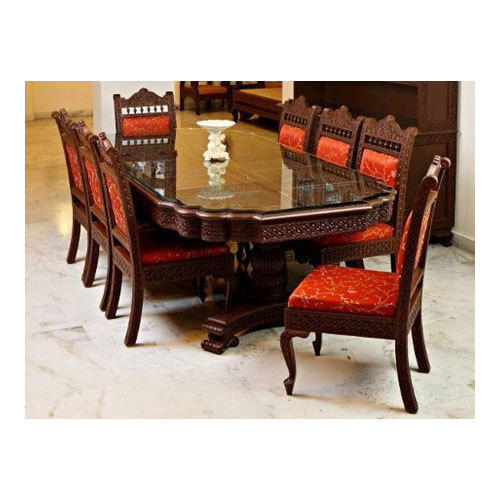Source of all Images in this Blog-post : Google Images : ‘Google Image Search’ will reveal the multiple sources of every single image shared in this Blog. For more details, kindly see ‘Disclaimer‘
Barmer Wood-Carvings of Rajasthan : Barmer has become famous for its variety of carved furniture. It also boasts of stone and mirror work, leather and cloth embroidery, printing and dyeing.
The carvings originated in the ancient Hindu and Jain temples scattered all over the state, for which local sculptors were employed. Jaisalmer, the desert outpost, where this craft actually has its roots, is full of havelis and forts with intricate stone carvings.
It is said that 40 years ago, Jawahar Ram Suthar, a resident of Undkha, 15 kilometres west of Barmer, brought the skills and traditions to the city. He is said to have been inspired by the Patvos Haveli in Jaisalmer.
Carved wooden furniture from Barmer got a major boost after the Indo – Pakistan wars.
Carved wooden furniture of Barmer – Buy Online
Barmer is the headquarters of the district of the same name. It is a small desert outpost, barely 50 kilometres from the international border. The landscape is semi-arid and barren, with little vegetation.
The town itself is clustered and dusty. There are a few manufacturers and dealers who involve local craftsmen to produce the craft furniture of this region.
Barmer is connected by train from Jodhpur, Jaipur, and Munnabao on the border. There are regular buses to most of the major cities in Rajasthan, as well as other nearby towns.
As mentioned earlier, the roots of the Barmeri craft furniture lie in the havelis and the forts of Jaisalmer. The base material used has gradually shifted from stone to wood.
For many years, right up to the 1960s, the craft was dormant. During the Indo—Pak wars, Barmer developed as a major military base.
Subsequently, the armymen took interest in the furniture, and provided the impetus and a ready market for the craftsmen to sell their products. This popularised the art and now the demand for this craft has crossed the national borders.
The salient feature of the Barmeri craft is its intricate carvings, and excellence in details. After an initial period of experimentation, innovation and finesse have become the hallmark of the furniture.
There are a few standard carving patterns which are used in various permutations and combinations.After the parts of the furniture are cut to size, they are marked for carving.
Various specialised hand tools are used to painstakingly carve out the details. Finally the finished pieces are joined together. There exists a sort of assembly line technique, where each person specialises in his particular job.
The completed items are finished by sanding, and then applications of stainers and spirit polishes which is topped by a coat of melamine. These are either brushed or sprayed on.
The major articles which are manufactured are sofas, dressing tables, beds, centre and side tables, lamps, trolleys, dining sets, diwans and settees.
Carved wooden furniture of Barmer – Buy Online
Carved wooden furniture of Barmer – Buy Online
Barmer Wood-Carvings of Rajasthan :
Barmer has become famous for its variety of carved furniture. It also boasts of stone and mirror work, leather and cloth embroidery, printing and dyeing. The carvings originated in the ancient Hindu and Jain temples scattered all over the state, for which local sculptors were employed.
Jaisalmer, the desert outpost, where this craft actually has its roots, is full of havelis and forts with intricate stone carvings.
It is said that 40 years ago, Jawahar Ram Suthar, a resident of Undkha, 15 kilometres west of Barmer, brought the skills and traditions to the city. He is said to have been inspired by the Patvos Haveli in Jaisalmer.
Carved wooden furniture from Barmer got a major boost after the Indo – Pakistan wars.
Barmer is the headquarters of the district of the same name. It is a small desert outpost, barely 50 kilometres from the international border. The landscape is semi-arid and barren, with little vegetation.
The town itself is clustered and dusty. There are a few manufacturers and dealers who involve local craftsmen to produce the craft furniture of this region.
Barmer is connected by train from Jodhpur, Jaipur, and Munnabao on the border. There are regular buses to most of the major cities in Rajasthan, as well as other nearby towns.
As mentioned earlier, the roots of the Barmeri craft furniture lie in the havelis and the forts of Jaisalmer. The base material used has gradually shifted from stone to wood.
For many years, right up to the 1960s, the craft was dormant. During the Indo—Pak wars, Barmer developed as a major military base.
Subsequently, the armymen took interest in the furniture, and provided the impetus and a ready market for the craftsmen to sell their products. This popularised the art and now the demand for this craft has crossed the national borders.
The salient feature of the Barmeri craft is its intricate carvings, and excellence in details. After an initial period of experimentation, innovation and finesse have become the hallmark of the furniture.
There are a few standard carving patterns which are used in various permutations and combinations.
After the parts of the furniture are cut to size, they are marked for carving. Various specialised hand tools are used to painstakingly carve out the details. Finally the finished pieces are joined together.
There exists a sort of assembly line technique, where each person specialises in his particular job. The completed items are finished by sanding, and then applications of stainers and spirit polishes which is topped by a coat of melamine. These are either brushed or sprayed on.
The major articles which are manufactured are sofas, dressing tables, beds, centre and side tables, lamps, trolleys, dining sets, diwans and settees.
Carved wooden furniture of Barmer – Buy Online
Carved wooden furniture of Barmer – Buy Online














